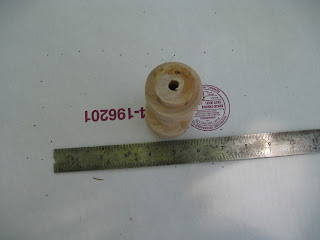Once again, I have gotten things wrong.
The long story is that after picking plums, I went to prune the plum tree and noticed that the olive needed pruning. Then, one of the olive branches looked just the correct size to make bobbins - and I always need bobbins.
I turned some blanks:
Green, the wood is soft and can be turned very fast - such a blank can be made in a couple of minutes. (There are a lot of wet sticky shavings. Sweep up will take longer than the turning!)
I let them dry a couple of days:
and turned spinning bobbins:
The long story is that after picking plums, I went to prune the plum tree and noticed that the olive needed pruning. Then, one of the olive branches looked just the correct size to make bobbins - and I always need bobbins.
I turned some blanks:
Green, the wood is soft and can be turned very fast - such a blank can be made in a couple of minutes. (There are a lot of wet sticky shavings. Sweep up will take longer than the turning!)
I let them dry a couple of days:
and turned spinning bobbins:
Boring the ends for 22 mm bearings was accomplished using a mandrel of sacrificial
3/8" wooden dowel.
The still slightly soft olive wood allowed turning the bobbin to size very quickly. The wood was free, so turning spinning bobbins from block of "green" olive was faster and cheaper than glueing up blanks. With the 3/8" hole down the center, the olive seems to dry fairly quickly without much cracking, warping or distortion.
The spindle turned (not board cut) whorls seem to work just fine, but we will see how they wear.
The new flyer/bobbin assembly in service.
Now, I had told people that because of the relatively small difference in rpm between the bobbin and the flyer, the bobbin bearings did not matter that much. However, with the same whorl sizes, this bobbin with ball bearings seems to allow the flyer/bobbin assembly to spin faster. A couple cups of coffee, and it will turn well over 4,000 rpm on a sustained basis. Of course, that is way too fast for fat, low twist yarns, but for hoisery singles wanting 17 tpi , that is only ~6.5 yards/ minute, and with well prepped worsted fiber, 6.5 yards per minute is easy enough to draft. It is hard on a ST wheel because the constant tension on the single from the ST flyer/bobbin assembly pulls the single apart before enough twist is inserted to hold the single together. (Same problem with a DD wheel set up for low twist yarns!) However, this DRS flyer/bobbin assembly only winds-on the single after it has inserted the right amount of twist to hold the single together. Thus, I do not have to worry about twist, I just focus on drafting.
On the other hand, drafting 5 to 10 yards per minute of 30,000 ypp to 20,000 ypp (66 m/g to 44 m/g) singles is enough to keep me focused on the job at hand. Finer, but not as high twist as sock yarn.
Yep, a ball bearing at the whorl end of the shaft,
is worth another couple of hundred rpm. e.g., 5% faster
As modified, AA's competition flyer will easily do 5,000 rpm with the bobbin running about 3% faster. I know I have said that before, but now the differential rotation speed is better controlled, and everything is smoother.
This flyer/bobbin/ assembly is now my choice for high twist sock yarns. It looks like it is worth while to put ball bearings everywhere. I apologize for saying that brass bushings were adequate for spinning bobbin bearings. I was following AA's lead, as he used brass bushings for spinning bobbin bearings.





.jpg)
No comments:
Post a Comment